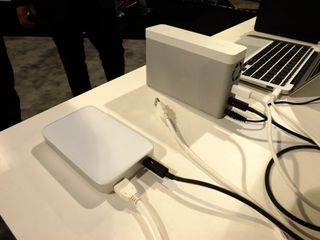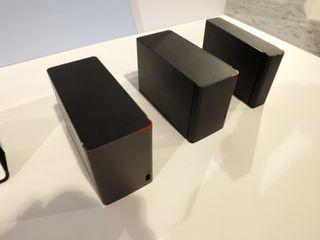Buffalo Shows Unannounced External SSD Drives
Buffalo is set to release a mobile and desktop external SSD with USB 3.0 and ThunderBolt connectivity.

During CES 2013, Buffalo Technology was displaying two unannounced products slated for 2013: a mobile external drive and a desktop external drive, both featuring SSDs. According to the rep, the mobile version had a single 256 GB SSD whereas the desktop version played host to two 256 GB SSDs in RAID 0.
As seen in the photograph (right), both models will sport a USB 3.0 port and a Thunderbolt port. The portable drive will offer write speeds up to 200 Mbps, and read speeds up to 400 Mbps. The desktop model will have up to 600 Mbps write speeds and up to 800 Mbps read speeds.

Also on show were the company's upcoming BuffaloLink (see announcement below) external storage products: one empty model with two drive bays, one with two installed HDDs up to 4 TB each in RAID 1, and a model with a single HDD up to 4 TB. Users will be able to access the stored files on the go without limits, meaning movies, TV shows and music can be streamed to smartphones and tablets without an additional fee or advanced firewall configurations. All three will ship at the end of Q1 or the beginning of Q2 of 2013.
Buffalo's CES "booth" also had on display a wide variety of products including colorful mice, ear buds, iPhone 5 cases, and mobile batteries for recharging smartphones and tablets when a power outlet isn't available. Also on hand were 802.11ac networking gear, and external storage stations for local and network solutions.
* Buffalo Introduces BuffaloLink Service for Simple, Secure Cloud Access
* Buffalo Showcases Assortment of Digital Life Solutions at CES


Contact Us for News Tips, Corrections and Feedback
Stay on the Cutting Edge
Join the experts who read Tom's Hardware for the inside track on enthusiast PC tech news — and have for over 25 years. We'll send breaking news and in-depth reviews of CPUs, GPUs, AI, maker hardware and more straight to your inbox.
-
happyballz Desktop model seems quick ... lets see some benches.Reply
Anyone else cringes when they hear/see "ThenderBolt" or "Cloud" word/phrase? Light Peak was much better name IMO. -
anti-painkilla I believe that Light Peak is Intel's proprietary interface, Thunderbolt is an Apple/Intel offset of this technology.Reply
Not entirely certain, but I would assume Intel renamed it so they can progress with Light Peak without Apple. I may be wrong and it was scraped and thunderbolt is now the only one. -
ddpruitt I'm not sure I see the point of putting an SSD in an enclosure. Yes there fast but by the time you get through all the speed penalties. Put a couple of HDDs in a RAID array and I'm sure you'll get similar performance for a lower cost and get higher capacity.Reply
I'd like to see some benchmarks on these guys. Maybe there's more to these than I can see. -
greghome Some of you might laugh, but I've been running my SanDisk SSD in a Buffalo mini station casing for half a year now ever since my laptop fried it's motherboard and my ext Hard Drive gave up :PReply -
alidan ddpruittI'm not sure I see the point of putting an SSD in an enclosure. Yes there fast but by the time you get through all the speed penalties. Put a couple of HDDs in a RAID array and I'm sure you'll get similar performance for a lower cost and get higher capacity.I'd like to see some benchmarks on these guys. Maybe there's more to these than I can see.Reply
lets take out real world preformance hits for this.
a single hdd gets about 100-150mb sustainable speed. where as most ssds worth mentioning max out their sata version, being about 300 read write and 600 read write (i know those numbers are lower in the real world, but im not looking them up to figure it out)
now to match a single ssd on read write performance, you would need to raid 4-6 hdds
but even with those 4-6 drives, you would never touch the seek time of an ssd, or the io performance of even the worst ones on the market.
and than, you are talking about a 4-6 drive array in raid 0, one drive goes, they all go.
if you are looking for speed, you sacrifice space because if speed was your concern, and space was an issue. you would have 8-12 drices, each costing 100$ and up, apposed to 1 200-400$ drive, who speed isn't even touched.
Most Popular


